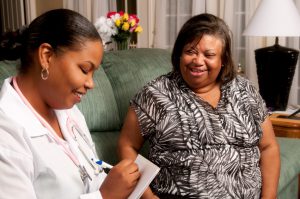Health Equity Lens Brings New Focus to MHQP’s Clinical Guidelines
(January 2021)
Two decades ago, in 2001, MHQP issued the first statewide Adult and Pediatric Preventive Care  Recommendations and Immunization Guidelines in Massachusetts. At that time, providers were receiving a different set of clinical guidelines from each of the health plans they worked with. Recognizing this situation as both confusing and wasteful, the health plans asked MHQP to step in as a neutral party to create a collaborative set of guidelines that all plans could support. We’ve continued to play this collaborative leadership role ever since, and clinicians throughout the state have come to depend on MHQP’s Guidelines to ensure every patient consistently receives evidence-based, best practice care. Each year since then, we have engaged in a comprehensive collaborative process to review and update these Guidelines with the most current clinical knowledge and practice.
Recommendations and Immunization Guidelines in Massachusetts. At that time, providers were receiving a different set of clinical guidelines from each of the health plans they worked with. Recognizing this situation as both confusing and wasteful, the health plans asked MHQP to step in as a neutral party to create a collaborative set of guidelines that all plans could support. We’ve continued to play this collaborative leadership role ever since, and clinicians throughout the state have come to depend on MHQP’s Guidelines to ensure every patient consistently receives evidence-based, best practice care. Each year since then, we have engaged in a comprehensive collaborative process to review and update these Guidelines with the most current clinical knowledge and practice.
Why Adopt a Health Equity Lens?
The pandemic has been devastating for all communities, but it has hit communities of color especially hard. Black patients have been three times as likely to be diagnosed with COVID-19 and two times as likely to die in comparison to their white counterparts. Health disparities of this magnitude are not new. Researchers have long been aware of health disparities affecting underserved communities for many noncommunicable diseases such as breast cancer, prostate cancer and colorectal cancer. But the pandemic has brought these problems into mainstream consciousness.
Of equal concern has been the sharp decrease in routine cancer screenings during the COVID-19 crisis. When lockdowns began in March, rates of screenings for breast, cervical and colon cancers decreased almost 90% compared to the prior year. Even when lockdowns eased in May and June, the rates of screening were still about 25% lower than normal. These patterns may disproportionately affect underserved communities who already have lower rates of cancer screening due to lack of access to quality clinicians and clinics. If these patterns continue to persist as the pandemic continues to ravage our country, the disparities seen in cancer rates for Black, Latinx, and Indigenous communities may continue to widen.
MHQP approached the review of our Guidelines this year with these issues as an undeniable backdrop. Although we have always included risk factors in our Guidelines to drive progress toward risk-based early detection efforts, this year we focused on incorporating a health equity lens to identify subpopulations that are disproportionately at-risk of certain conditions, diseases, and cancers, considering both biological pre-dispositions and the social determinants of health.
“Our goal for the Guidelines is to help build awareness among clinicians of the multiple socioeconomic and cultural issues that can impact the health of the diverse populations with whom they work,” said MHQP CEO Barbra Rabson. “Ultimately, we hope the changes we’ve made serve as a first step in improving health outcomes for groups that have been systematically and unfairly affected by the biases embedded in our healthcare system.”
Changes This Year
Our first step in overhauling the Guidelines this year was to review the literature regarding screenable cancers, cardiovascular diseases, mental illness, and other preventable conditions to determine which populations are at higher risk for these diseases and the reasons behind these higher risk profiles.
In many cases, biological factors are the cause for certain groups to be predisposed to certain diseases. For this reason, the updated Guidelines include targeted statements about who is at higher risk for different diseases and recommendations for screenings that address that risk. For example, Black men have a higher prevalence of some specific variations of genes and single nucleotide polymorphisms (SNPs) that increase their risk of developing prostate cancer. As a result, they are 50% more likely to develop prostate cancer than any other group of men and twice times as likely to die from this aggressive disease. The updated Guidelines address this fact by suggesting Black men start to get screened at age 40, while all other men should be screened starting at age 45. With increased awareness of factors that disproportionately impact the health of certain populations, clinicians can catch illnesses early enough to start treatment interventions and decrease mortality rates.
While genetic differences certainly play a role in establishing risk profile, biology is actually a very small contributor compared to social determinants of health. The major factors that govern disease development are an individual’s social, economic and cultural circumstances. The World Health Organization defines the social determinants of health as “conditions in which people are born, grow, live, and work and age [that] are shaped by the distribution of money, power, and resources at global, national, and local levels.” Social determinants can either help a patient’s health (like living in a low crime neighborhood), or adversely affect it (such as living in a neighborhood with poor air quality and pollutants). Conditions can be modifiable, like food insecurity or homelessness, or unmodifiable, like race or age. To help address these realities, we added a social determinants section to the Guidelines this year, which encourage clinicians to screen for issues such as housing or food access and recommend appropriate community resources to help the patient respond to areas of concern.
“MHQP’s Clinical Guidelines are an essential resource for the Massachusetts healthcare community,” said Mark Kennedy, Senior Program Manager of the Chronic Disease Division at the Boston Public Health Commission, one of the key champions of MHQP’s Guidelines. “We are especially grateful for their collaborative leadership in taking a risk-based approach to address deep rooted issues related to health disparities.”
“These Guidelines are just the beginning of a long battle to dismantle the many, many structural barriers we still need to overcome as a society,” said Rabson. “We believe the changes we have made this year to MHQP’s Clinical Guidelines point us in the right direction for achieving better outcomes for underserved populations.”
Please click HERE to go to MHQP’s newly revised Clinical Guidelines.
